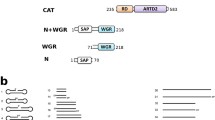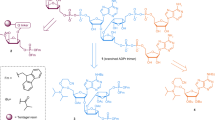Abstract
Human nuclear poly(ADP-ribosyl)transferase (ADPRT) modifies proteins with branched ADP-ribose-polymers. Various proteins, including ADPRT itself, serve as acceptors for polyADP-ribose. Target proteins include those controlling basic cellular processes such as DNA repair, differentiation and proliferation. Because of the outstanding features of this enzyme: automodification, several functional domains and central role in physiology of the cell, the molecular biology of ADPRT gained wide interest. The promoter structure contains several CCAAT/TATA boxes and SP1 sites. However, there is no CCAAT/TATA box in the neighbourhood of an SP1 site and, thus no obvious site for initiation of transcription. Within this region there are several noteworthy inverted repeats, which by internal basepairing could form two types of cruciform structures. Deletion analysis revealed that these cruciform structures have functional significance. Removal of one type increases the promoter activity, whereas removal of the other diminishes the promoter function.
Overexpression of ADPRT from heterologous promoters (MMTV, SV40) leads to repression of the activity of the ADPRT promoter. Indeed, ADPRT was shown to bind specifically to one type of cruciform structure. This specific interaction indicates autorepression of the ADPRT gene: the enzyme ADPRT acts directly as a negative modulator of the activity of its own promoter.
Similar content being viewed by others
References
Althaus FR, Richter C: ADP-ribosylation of proteins: Enzymology and biological significance. Molecular Biol Biochem and Biophys 37:1–226, 1987
Burtscher HJ, Klocker H, Schneider R, Auer B, Hirsch-Kauffmann M, Schweiger M: ADP-ribosyltransferase from Helix pomatia. Purification and characterization. Biochem J 248:859–864, 1987
Burtscher HJ, Schneider R, Klocker H, Auer B, Hirsch-Kauffmann M, Schweiger M: ADP-ribosyltransferase is highly conserved: Purification and characterization of ADP-ribosyltransferase from a fish and its comparison with the human enzyme. J Comp Physiol Biol 157:567–572, 1987
Gradwohl G, Ménissier-De Murcia JM, Molinete M, Simonin F, Koken M, Hoeijmakers JHJ, De Murcia G: The second zinc-finger domain of Poly (ADP-ribose) polymerase determines specificity for single-stranded breaks in DNA. Proc Natl Sci USA 87:2990–2994, 1990
Sastry SS, Kun E: The interaction of adenosine diphosphoribosyl transferase (ADPRT) with a cruciform DNA. Biochem Biophys Res Commun 167:842–847, 1990
Herzog H, Zabel BU, Schneider R, Auer B, Hirsch-Kauffmann M, Schweiger M: Human nuclear NAD+ ADP-ribosyltranferase: Localization of the gene on chromosome 1q41-q42 and expression of an active human enzyme inEscherichia coli. Proc Natl Acad Sci USA 86: 3514–3518, 1989
Schweiger M, Auer B, Herzog H, Hirsch-Kauffmann M, Kaiser P, Flick K, Nagl U, Schneider R: Molecular biology of human Nuclear NAD+: ADP-Ribosyl-transferase (Polymerizing). In G.G. Poirier and P. Moreau (eds) ADP-Ribosylation Reactions. Springer-Verlag, New York, 1992, pp 20–30
Bhatia K, Pommier Y, Giri C, Fornance AJ, Imaizumi M, Breitmann TR, Cherney B, Smulson M: Expression of the poly(ADP-ribose) polymerase gene following natural and induced DNA strand breakage and effect of hyperexpression on DNA repair. Carcinogenesis 11:123–128, 1990
Negroni M, Bertazzoni U: Differential expression and stability of poly (ADP-ribose) polymerase mRNA in human cells. Biochimica et Biophysica Acta 1173:133–140, 1993
Wein KH, Netzker R, Brand K: Cell cycle-related expression of poly(ADP-ribosyl)transferase in proliferating rat thymocytes. Biochimica et Biophysica Acta 1176:69–76, 1993
Burtscher HJ, Auer B, Klocker H, Schweiger M, Hirsch-Kauffmann M: Isolation of ADP-ribosyltransferase by affinity chromatography. Anal Biochem 152:285–290, 1986
Schneider R, Auer B, Kühne C, Herzog H, Klocker H, Burtscher HJ, Hirsch-Kauffmann M, Wintersberger U, Schweiger M: Isolation of a cDNA clone for human NAD+: protein ADP-ribosyltransferase. Eur J Cell Biol 44: 302–307, 1987
Alkhatib HM, Chen D, Cherney B, Bhatia K, Notario V, Giri C, Stein G, Slattery E, Roeder RG, Smulson M: Cloning and expression of cDNA for human poly (ADP-ribose) polymerase. Proc Natl Acad Sci USA 84: 1224–1228, 1987
Kurosaki T, Ushiro H, Mitsuchi Y, Suzuki S, Matsuda M, Matsuda Y, Katanuma N, Kanugawa K, Matsuo H, Hirose T, Inayama S, Shizuta Y: Primary structure of human poly (ADP-ribose) synthetase deduced from cDNA sequence. J Biol Chem 262:15990–15997, 1987
Uchida K, Morita T, Sato T, Ogura T, Yamashita R, Noguchi S, Suzuki H, Nyunoya H, Miwa M, Sugimura T: Nucleotide sequence of a full-length DNA for human fibroblast poly (ADP-ribose)-polymerase. Biochem Biophys Res Comm 148:617–622, 1987
Auer B, Nagl U, Herzog H, Schneider R, Schweiger M: Human nuclear NAD+ ADP-ribosyltransferase(polymerizing): Organization of the gene. DNA 8:575–580, 1989
Struve I, Rausch T, Bernasconi, P, Taiz L: Structure and function of the promoter of the Carrot V-type H+-ATPase catalytic subunit gene. J Biol Chem 265:7927–7932, 1990
Gourse RL, Sharrock RA, Nomura M: Control of Ribosome Synthesis inEscherichia coli In B., Hardesty and G. Kramer (eds). Structure and Function, and Genetics of Ribosomes. Springer-Verlag, New York, 1985, pp 766–788
Fainsod A, Leonhard DB, Ruusala T, Lubin M, Crothers D, Ruddle FH: The homeo domain of a murine protein binds 5′ to its own homeo box. Proc Natl Acad Sci USA 83:9532–9536, 1986
Magasanik B: Reversible phosphorylation of an enhancer binding protein regulates the transcription of bacterial nitrogene utilization. TIBS 13: 475–479, 1988
Author information
Authors and Affiliations
Rights and permissions
About this article
Cite this article
Oei, S.L., Herzog, H., Hirsch-Kauffmann, M. et al. Transcriptional regulation and autoregulation of the human gene for ADP-ribosyltransferase. Mol Cell Biochem 138, 99–104 (1994). https://doi.org/10.1007/BF00928449
Issue Date:
DOI: https://doi.org/10.1007/BF00928449




